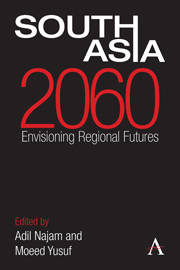Book contents
- Frontmatter
- Contents
- Acknowledgments
- List of Abbreviations
- Introduction: Imagining South Asian Futures
- Section I South Asia as a Region
- Section II State Relations
- Section III Development
- Chapter 16 South Asian Economy in 2060
- Chapter 17 Economic Futures: Challenges Ahead
- Chapter 18 South Asia in the Asian Economy: Struggling to Overcome History
- Chapter 19 Globalization and South Asia
- Chapter 20 Trade Relations: Some Predictions and Lessons
- Chapter 21 Urban Policy for Environmental Quality and Well-Being
- Chapter 22 Urban Futures, Urban Challenges
- Chapter 23 Water Security: Risks and Responses
- Chapter 24 Agriculture and Food Security
- Chapter 25 Meeting Electric Power Demand in South Asia
- Chapter 26 E-South Asia: A Social Science Fiction
- Section IV Human Well-Being
- About the Authors
- Bibliography
- Index
Chapter 22 - Urban Futures, Urban Challenges
from Section III - Development
Published online by Cambridge University Press: 05 September 2013
- Frontmatter
- Contents
- Acknowledgments
- List of Abbreviations
- Introduction: Imagining South Asian Futures
- Section I South Asia as a Region
- Section II State Relations
- Section III Development
- Chapter 16 South Asian Economy in 2060
- Chapter 17 Economic Futures: Challenges Ahead
- Chapter 18 South Asia in the Asian Economy: Struggling to Overcome History
- Chapter 19 Globalization and South Asia
- Chapter 20 Trade Relations: Some Predictions and Lessons
- Chapter 21 Urban Policy for Environmental Quality and Well-Being
- Chapter 22 Urban Futures, Urban Challenges
- Chapter 23 Water Security: Risks and Responses
- Chapter 24 Agriculture and Food Security
- Chapter 25 Meeting Electric Power Demand in South Asia
- Chapter 26 E-South Asia: A Social Science Fiction
- Section IV Human Well-Being
- About the Authors
- Bibliography
- Index
Summary
The Study of Urbanization
The beginning of the second half of the twentieth century witnessed – among other things – three spectacular developments in Asia's sociopolitical transition: the birth of new nations, population explosion and rapid urbanization. They are related to one another and point the way to a foreseeable future of urbanization. In the following decades, the period also witnessed a notable resurgence of academic interest in population and urbanization in South Asia, which continually redefined the public interest. Initiated by Bert Hoselitz, the study of urbanization in relation to economic development emphasized the role of cities in mobilizing manpower and material resources for industrialization. The urban view of economic development was gaining ground in the 1960s along with the negative hypotheses of overurbanization and urban bias in Third World development; the combination of the two processes generates slow and inequitable growth in developing countries. The large and growing urban population was disproportionately employed in the service sector relative to the manufacturing sector, characterizing urbanization in South Asia. This pattern was in contrast to the development “at comparable levels of urbanization,” which accompanied structural transformation in rich industrialized countries. Since economic growth is associated with the reallocation of labor and capital away from the traditional, low-wage rural sector to modern, high-wage urban sector, the city becomes the locus of economic power. The spatial transformation of man, material and capital – which gives rise to urbanization – contributes to a higher rate of economic growth because households and firms benefit from agglomeration economies of scale through network, civic facilities, information, mobility and specialization in given locations of cities and their surroundings.
- Type
- Chapter
- Information
- South Asia 2060Envisioning Regional Futures, pp. 169 - 176Publisher: Anthem PressPrint publication year: 2013

